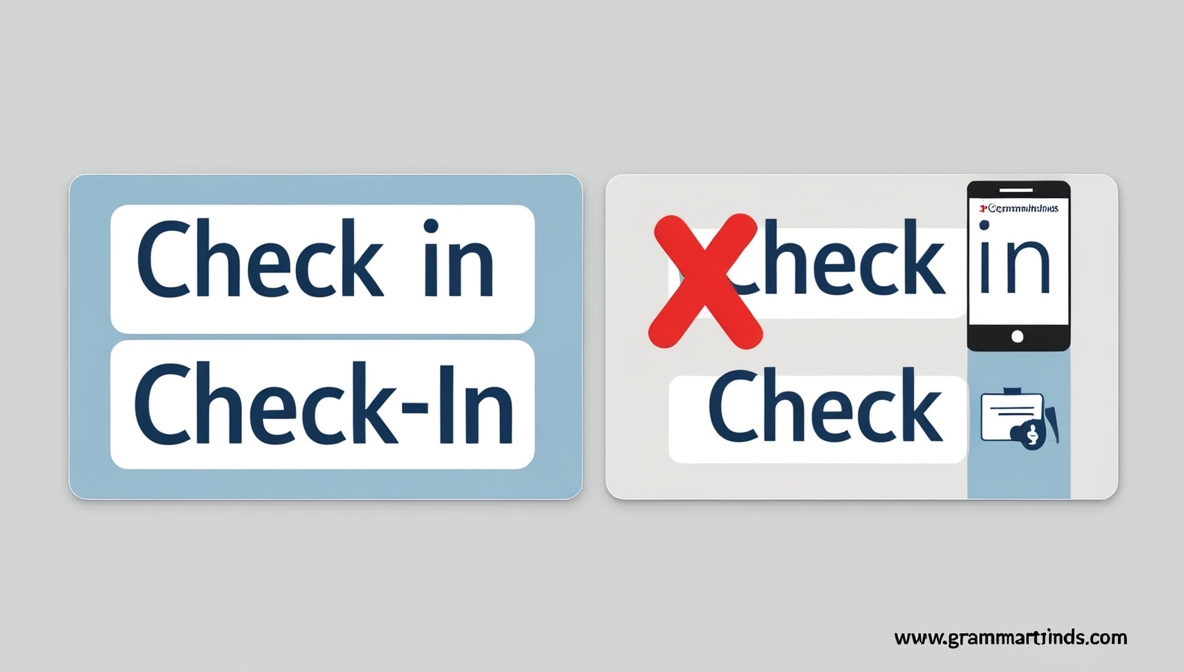If you’ve ever paused while writing check in, check-in, or checkin, you’re not alone. These forms confuse many English speakers, especially in writing. Understanding the difference between check in and check-in matters more than you might think especially in professional communication, travel documents, or even daily work reports. In this guide, you’ll learn the check-in definition, check in definition, and when and how to use each form correctly.
What’s the Confusion About?
It’s easy to mix up these terms because they look and sound almost identical. But their part of speech, function in a sentence, and spelling rules are all different. Knowing whether to use check in, check-in, or avoid checkin altogether depends on grammar, context, and tone.
Let’s clear it up.
The Difference Between Check in and Check-in
Understanding the check-in vs check in grammar rule starts with identifying parts of speech. One is a verb phrase, the other a hyphenated word (used as a noun or adjective).
| Term | Part of Speech | Usage Example |
|---|---|---|
| check in | Verb phrase | I’ll check in at the desk. |
| check-in | Noun / Adjective | The check-in process was smooth. |
| checkin | ❌ Incorrect spelling | Avoid using “checkin” in formal writing |
Check in Definition and Usage
“Check in” is a verb phrase made of the action verb “check” and the preposition “in.” It describes the action of registering, confirming attendance, or arriving at a place like a hotel, airport, or event.
This is the form to use when you or someone is actively doing the action of checking in.
✅ When to use check in: Use it when someone is performing the act of arriving or registering somewhere.
Examples:
- I’ll check in at the front desk around noon.
- Don’t forget to check in when you get to the event.
- She checked in using the mobile app.
Check-in Definition and Usage
“Check-in” is a hyphenated word, used as either a noun or a phrasal adjective. It refers to a process, time, place, or event. You’ll often see this form in phrases like check-in time, check-in desk, or check-in process.
✅ When to use check-in: Use it to describe things related to the event or process of checking in.
Examples:
- The check-in time is after 3 PM.
- Head to the check-in area on the right.
- Online check-in is now available.
Checkin – Why It’s Not Correct
While you might see checkin online or in casual messages, it’s not a recognized English word. It’s often a typo or an informal shortcut, especially in usernames, app buttons, or social media tags.
❌ Checkin is not standard. Don’t use it in formal or professional writing.
If you’re aiming for correct English usage rules, checkin should be avoided.
When to Use Check in vs Check-in
Let’s simplify when to choose one over the other. The key is understanding noun vs verb roles.
Use check in when:
- You need a verb phrase
- Someone is doing the action
Use check-in when:
- You’re referring to a thing, place, or process
- It’s functioning as a noun or adjective
Real-World Usage in Context
The difference becomes more obvious in real situations. Here’s how they’re used in industries like travel, business, and tech.
Travel Industry Terminology
- Hotel check-in usually starts at 2 PM.
- You must check in at the gate 30 minutes before departure.
- Visit the check-in desk to confirm your reservation.
Workplace Communication
- Let’s check in with the team on progress.
- We’ll have a daily check-in at 9 AM.
Mobile Apps & Technology
- Tap “Check In” to log your visit.
- Some fitness apps offer a weekly check-in feature.
Common Mistakes to Avoid
Understanding the difference between check in and check-in helps you avoid these frequent slip-ups:
❌ Don’t Hyphenate a Verb Phrase
Incorrect: I’ll check-in at 4 PM. Correct: I’ll check in at 4 PM.
❌ Don’t Use “Checkin”
Incorrect: I used the mobile checkin. Correct: I used the mobile check-in.
Quick Tips to Remember
- Check in = action (verb)
- Check-in = thing/process (noun or adjective)
- Checkin = ❌ not a real word
Recap: Check-in vs Check in at a Glance
| Form | Function | Correct Use | Example |
|---|---|---|---|
| check in | Verb phrase | Describes the act of arriving or registering | We will check in at the hotel. |
| check-in | Noun/Adjective | Refers to the process, time, or place | The check-in was smooth. |
| checkin | ❌ Incorrect | Avoid in formal writing | “Checkin” is a common misspelling. |
FAQs
Is it ever correct to write “checkin” as one word?
No, checkin is not grammatically correct and should be avoided.
What’s the plural of “check-in”?
The correct plural is check-ins, used when referring to multiple processes or events.
Is “check-in” one word or two?
It’s one hyphenated word when used as a noun or adjective; two words when used as a verb phrase.
Final Thoughts
Understanding when to use check in versus check-in is a simple way to polish your grammar and boost clarity in your writing. Remember: if someone is doing something, it’s check in. If you’re talking about what or where, it’s check in. And if you ever type checkin, hit that backspace English usage rules don’t approve.
Bookmark this guide and check back whenever you’re unsure. A small dash (or space) can make a big difference.
